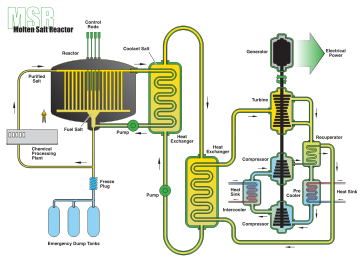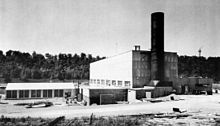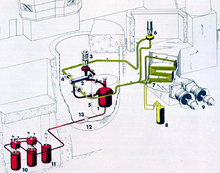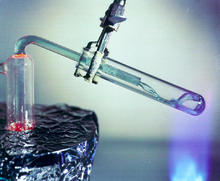- Molten salt reactor
-
A molten salt reactor (MSR) is a type of nuclear fission reactor in which the primary coolant, or even the fuel itself is a molten salt mixture. MSRs run at higher temperatures than water-cooled reactors for higher thermodynamic efficiency, while staying at low vapor pressure.
The ability to operate at near atmospheric pressures reduces the mechanical stress endured by the system, thus simplifying aspects of reactor design and improving safety. The nuclear fuel may be solid fuel rods or dissolved in the coolant itself.
In many designs the nuclear fuel is dissolved in the molten fluoride salt coolant as uranium tetrafluoride (UF4). The fluid becomes critical in a graphite core which serves as the moderator. Fluid fuel reactors have significantly different safety issues compared to solid fuel designs; the potential for major reactor accidents is reduced, while the potential for processing accidents is increased.[1]
More recent research has focused on the practical advantages of the high-temperature low-pressure primary cooling loop. Many modern designs rely on ceramic fuel dispersed in a graphite matrix, with the molten salt providing low pressure, high temperature cooling. The salts are much more efficient at removing heat from the core, reducing the need for pumping, piping, and reducing the size of the core as these components are reduced in size.
The early Aircraft Reactor Experiment (1954) was primarily motivated by the small size that the design could provide, while the Molten-Salt Reactor Experiment (1965–1969) was a prototype for a thorium fuel cycle breeder reactor nuclear power plant. One of the Generation IV reactor designs is a molten salt-cooled, solid-fuel reactor; the initial reference design is 1000 MWe with a deployment target date of 2025.
Another advantage of a small core is that it has fewer materials to absorb neutrons. In a reactor employing thorium fuel, the improved neutron economy makes more neutrons available to breed thorium-232 into uranium-233. Thus, the compact core makes the molten salt design particularly suitable for the thorium fuel cycle.
Contents
History
The Aircraft Reactor Experiment
Extensive research into molten salt reactors started with the U.S. Aircraft Reactor Experiment (ARE) in support of the U.S. Aircraft Nuclear Propulsion program. The ARE was a 2.5 MWth nuclear reactor experiment designed to attain a high power density for use as an engine in a nuclear powered bomber. The project included several reactor experiments including high temperature reactor and engine tests collectively called the Heat Transfer Reactor Experiments: HTRE-1, HTRE-2, and HTRE-3 at the National Reactor Test Station (now Idaho National Laboratory) as well as an experimental high-temperature molten salt reactor at Oak Ridge National Laboratory - the ARE. The ARE used molten fluoride salt NaF-ZrF4-UF4 (53-41-6 mol%) as fuel, was moderated by beryllium oxide (BeO), used liquid sodium as a secondary coolant, and had a peak temperature of 860 °C. It operated for 100 MW-hours over nine days in 1954. This experiment used Inconel 600 alloy for the metal structure and piping.[2]
The Molten-Salt Reactor Experiment
Oak Ridge National Laboratory (ORNL) took the lead in researching the MSR through 1960s, and much of their work culminated with the Molten-Salt Reactor Experiment (MSRE). The MSRE was a 7.4 MWth test reactor simulating the neutronic "kernel" of a type of inherently safe epithermal thorium molten salt breeder reactor called the Liquid fluoride thorium reactor. It tested molten salt fuels of uranium and plutonium. The tested 233UF4 fluid fuel has a unique decay path that minimizes waste. The 650 °C temperature of the reactor could power high-efficiency heat engines such as gas turbines. The large, expensive breeding blanket of thorium salt was omitted in favor of neutron measurements.
The MSRE was located at ORNL. Its piping, core vat and structural components were made from Hastelloy-N and its moderator was pyrolytic graphite. It went critical in 1965 and ran for four years. The fuel for the MSRE was LiF-BeF2-ZrF4-UF4 (65-30-5-0.1), the graphite core moderated it, and its secondary coolant was FLiBe (2LiF-BeF2). It reached temperatures as high as 650 °C and operated for the equivalent of about 1.5 years of full power operation.
Oak Ridge National Laboratory Molten Salt Breeder Reactor
The culmination of the Oak Ridge National Laboratory research during the 1970–76 timeframe resulted in an Molten Salt Breeder Reactor (MSBR) design which would use LiF-BeF2-ThF4-UF4 (72-16-12-0.4) as fuel, was to be moderated by graphite with a 4 year replacement schedule, use NaF-NaBF4 as the secondary coolant, and have a peak operating temperature of 705 °C.[3]
The molten salt reactor offers many potential advantages:[3]
- inherently safe design (safety by passive components and the strong negative temperature coefficient of reactivity)
- using an abundant supply of thorium to breed uranium-233 fuel.
- much cleaner: as a full recycle system, the discharge wastes from the reactor are predominately fission products, most of which have relatively short half lives compared to longer-lived actinide wastes. This can result in a significant reduction in the containment period in a geologic repository (300 years vs. tens of thousands of years)
- can "burn" some problematic radioactive waste (with transuranic elements from traditional solid-fuel nuclear reactors)
- possible even in small, even 2–8 MW(thermal) or 1–3 MW(electric). Submarine or aircraft size is possible
- can react to load changes in less than 60 seconds (unlike "traditional" solid-fuel nuclear power plants)
Recent Developments
Liquid salt very high temperature reactor
Research is currently picking up again for reactors that utilize molten salts for coolant. Both the traditional molten salt reactor and the Very High Temperature Reactor (VHTR) have been selected as potential designs to be studied under the Generation Four Initiative (GEN-IV). A version of the VHTR currently being studied is the Liquid Salt Very High Temperature Reactor (LS-VHTR), also commonly called the Advanced High Temperature Reactor (AHTR). It is essentially a standard VHTR design that uses liquid salt as a coolant in the primary loop, rather than a single helium loop. It relies on "TRISO" fuel dispersed in graphite. Early AHTR research focused on graphite would be in the form of graphite rods that would be inserted in hexagonal moderating graphite blocks, but current studies focus primarily on pebble-type fuel. The LS-VHTR has many attractive features, including: the ability to work at very high temperatures (the boiling point of most molten salts being considered are >1400 °C), low pressure cooling that can be used to more easily match hydrogen production facility conditions (most thermo chemical cycles require temperatures in excess of 750 °C), better electric conversion efficiency than a helium cooled VHTR operating at similar conditions, passive safety systems, and better retention of fission products in the event of an accident. This concept is now referred to as Fluoride Salt Cooled High Temperature Reactor (FHR).[4]
Liquid fluoride thorium reactor
The research and development of molten thorium salt fueled MSR variant called LFTR is also picking up. Private companies from Japan, Russia, USA and well as Chinese government expressed interest to develop the technology.
The Fuji MSR
The FUJI MSR is a 100 to 200 MWe LFTR, using technology similar to the Oak Ridge National Laboratory Reactor. It is being developed by a consortium including members from Japan, the U.S. and Russia. It would likely take 20 years to develop a full size reactor[5] but the project seems to lack funding.[6]
Chinese Thorium MSR project
The People’s Republic of China has initiated a research and development project in thorium molten-salt reactor technology. It was formally announced at the Chinese Academy of Sciences (CAS) annual conference in January 2011. Its ultimate target is to investigate and develop a thorium based molten salt nuclear system in about 20 years.[7][8][9]
Flibe Energy
Kirk Sorensen, former NASA scientist and Chief Nuclear Technologist at Teledyne Brown Engineering, has been a long time promoter of thorium fuel cycle and particularly liquid fluoride thorium reactors. In 2011, Sorensen founded Flibe Energy, a company aimed to develop 20-50 MW LFTR reactor designs to power military bases. (it is easier to approve novel military designs than civilian power station designs in today's US nuclear regulatory environment).[10][11][12][13]
The Weinberg Foundation
The Weinberg Foundation is a British non-profit organisation founded in 2011 dedicated to promotion and development of a liquid fluoride thorium reactor.[14][15][16]
Molten-salt fueled reactors
The classic MSFR, especially the thorium-fueled variant called Liquid fluoride thorium reactor, has been very exciting to many nuclear engineers. Its most prominent champion was Alvin Weinberg, who patented the light-water reactor and was a director of the U.S.'s Oak Ridge National Laboratory, a prominent nuclear research center. It has recently been the subject of a renewed interest.
Molten-salt cooled reactors
Molten-salt-fueled reactors are quite different from molten-salt-cooled solid-fuel reactors, called simply "Molten Salt Reactor System" in the Generation IV proposal, also called MSCR, which is also the acronym for the Molten Salt Converter Reactor design. It cannot reprocess fuel easily and has fuel rods that need to be fabricated and validated, delaying deployment by up to twenty years[citation needed] from project inception. However, since it uses fabricated fuel, reactor manufacturers can still profit by selling fuel assemblies.
The MSCR retains the safety and cost advantages of a low-pressure, high-temperature coolant, also shared by liquid metal cooled reactors. Notably, there is no steam in the core to cause an explosion, and no large, expensive steel pressure vessel. Since it can operate at high temperatures, the conversion of the heat to electricity can also use an efficient, lightweight Brayton cycle gas turbine.
Much of the current research on MSCRs is focused on small compact heat exchangers. By using smaller heat exchangers, less molten salt needs to be used and therefore significant cost savings could be achieved.
Molten salts can be highly corrosive, more so as temperatures rise. For the primary cooling loop of the MSR, a material is needed that can withstand corrosion at high temperatures and intense radiation. Experiments show that Hastelloy-N and similar alloys are quite suited to the tasks at operating temperatures up to about 700 °C. However, long-term experience with a production scale reactor has yet to be gained. Higher operating temperatures would be desirable, but at 850 °C thermo chemical production of hydrogen becomes possible, which creates serious engineering difficulties. Materials for this temperature range have not been validated, though carbon composites, molybdenum alloys (e.g. TZM), carbides, and refractory metal based or ODS alloys might be feasible.
Fused salt selection
The salt mixtures are chosen to make the reactor safer and more practical. Fluorides are favored because fluorine does not need expensive isotope separation (as chlorine does). It does not easily become radioactive under neutron bombardment. It also absorbs fewer neutrons and slows ("moderates") neutrons better. Low-valence fluorides boil at high temperatures, though many pentafluorides and hexafluorides boil at low temperatures. They also must be very hot before they break down into their simpler components, such molten salts are "chemically stable" when maintained well below their boiling points.
Reactor salts are also eutectic mixtures to reduce their melting point. This makes a heat engine more efficient, because more heat can be removed from the salt before reheating it in the reactor.
Some salts are so useful that isotope separation is worthwhile. Chlorides permit fast breeder reactors to be constructed using molten salts. Not nearly as much work has been done on reactor designs using them. Chlorine must be purified to chlorine-37 to reduce production of sulfur tetrafluoride when the radioactive chlorine decays to sulfur. Also, any lithium in a salt mixture must be purified lithium-7 to reduce tritium production (the tritium forms hydrogen fluoride).
Due to the high "redox window" of fused fluoride salts, the chemical potential of the fused salt system can be changed. Fluorine-Lithium-Beryllium ("FLiBe") can be used with beryllium additions to lower the electrochemical potential and almost eliminate corrosion. However, since beryllium is extremely toxic, special precautions must be engineered into the design to prevent its release into the environment. Many other salts can cause plumbing corrosion, especially if the reactor is hot enough to make highly reactive hydrogen.
To date, most research has focused on FLiBe, because Lithium and Beryllium are reasonably effective moderators, and form a eutectic salt mixture with a lower melting point than each of the constituent salts. Beryllium also performs neutron doubling, improving the neutron economy. This process occurs when the Beryllium nucleus re-emits two neutrons after absorbing a single neutron. For the fuel carrying salts, generally 1% or 2% (by mole) of UF4 is added. thorium and plutonium fluorides have also been used. The MSFR is the only system that has run a single reactor, the MSRE, from all three known nuclear fuels.
Comparison of the neutron capture and moderating efficiency of several materials. Red are Be-bearing, blue are ZrF4-bearing and green are LiF-bearing salts.[17] Material Total neutron capture
relative to graphite
(per unit volume)Moderating ratio
(Avg. 0.1 to 10 eV)Heavy water 0.2 11449 Light water 75 246 Graphite 1 863 Sodium 47 2 UCO 285 2 UO2 3583 0.1 2LiF–BeF2 8 60 LiF–BeF2–ZrF4 (64.5–30.5–5) 8 54 NaF–BeF2 (57–43) 28 15 LiF–NaF–BeF2 (31–31–38) 20 22 LiF–ZrF4 (51–49) 9 29 NaF–ZrF4 (59.5–40.5) 24 10 LiF-NaF–ZrF4 (26–37–37) 20 13 KF–ZrF4 (58–42) 67 3 RbF–ZrF4 (58–42) 14 13 LiF–KF (50–50) 97 2 LiF–RbF (44–56) 19 9 LiF–NaF–KF (46.5–11.5–42) 90 2 LiF–NaF–RbF (42–6–52) 20 8 Fused salt purification and reprocessing
Salts must be extremely pure initially, and would most likely be continuously cleaned in a large-scale molten salt reactor. Any water vapor in the salt will form hydrofluoric acid (HF) which is extremely corrosive. Other impurities can cause non-beneficial chemical reactions and would most likely have to be cleansed from the system. In conventional power plants where water is used as a coolant, great pains are taken to purify and deionize the water to reduce its corrosive properties.
The possibility of online reprocessing can be an advantage of the MSR design. Continuous reprocessing would reduce the inventory of fission products, control corrosion and improve neutron economy by removing fission products with high neutron absorption cross-section, especially Xenon. This makes the MSR particularly suited to the neutron-poor thorium fuel cycle. In some thorium breeding scenarios, the intermediate product protactinium-233 would be removed from the reactor and allowed to decay into highly pure uranium-233, an attractive bomb-making material. If left in the fuel, protactinium would absorb too many neutrons to make breeding with a graphite moderator and thermal spectrum possible. More modern design propose to use a larger quantity of thorium. This dilutes the protactinium to such an extent that few protactinium atoms absorb a second neutron or, via a (n, 2n) reaction (in which an incident neutron is not absorbed but instead knocks a neutron out of the nucleus), generate uranium-232. Because U-232 has a short half-life and its decay chain contains hard gamma emitters, it makes the isotopic mix of uranium less attractive for bomb-making. This benefit would come with the added expense of processing a larger quantity of blanket salt. Other designs propose to use heavy water as a super efficient moderator to improve neutron economy allowing more loss to protactinium absorption. However these designs would operate at lower temperatures and thus lower thermal efficiency. The necessary fuel salt reprocessing technology has been demonstrated, but only at laboratory scale. A prerequisite to full-scale commercial reactor design is the R&D to engineer a economically competitive fuel salt cleaning system.
Political issues
To exploit the molten salt reactor's breeding potential to the fullest, the reactor must be co-located with a reprocessing facility. Nuclear reprocessing does not occur in the U.S. because no commercial provider is willing to undertake it. The regulatory risk and associated costs are very great because the regulatory regime has varied dramatically in different administrations.[18] UK, France, Japan, Russia and India currently operate some form of fuel reprocessing.
Some U.S. Administration departments have feared that fuel reprocessing in any form could pave the way to the plutonium economy with its associated proliferation dangers.[19]
A similar argument led to the shutdown of the Integral Fast Reactor project in 1994.[20] The proliferation risk for a thorium fuel cycle stems from the potential separation of uranium-233, which might be used in nuclear weapons, though only with considerable difficulty.
Comparison to ordinary light water reactors
MSRs can be safer than ordinary light water reactors. Molten salts trap fission products chemically, and react slowly or not at all in air. Also, the fuel salt does not burn in air or water. The core and primary cooling loop is operated at near atmospheric pressure, and has no steam, so a pressure explosion is impossible. Even in the case of an accident, most radioactive fission products would stay in the salt instead of dispersing into the atmosphere. A molten core is meltdown-proof, so the worst possible accident would be a leak.[3] In this case, the fuel salt can be drained into passively cooled storage, managing the accident. Neutron-producing accelerators have even been proposed for some super-safe subcritical experimental designs, and the initiation of thorium transmutation to 233U can be directly accomplished with what is essentially a medical proton-beam source.[21]
Some types of molten salt reactors are very inexpensive. Since the core and primary coolant loop are low pressure, it can be constructed of thin, relatively inexpensive weldments. So, it can be far less expensive than the massive pressure vessel required by the core of a light water reactor. Also, some form of fluid-fueled thorium breeder could use less fissile material per megawatt than any other reactor. Molten salt reactors can run at extremely high temperatures, yielding high efficiencies to produce electricity. The temperatures of some proposed designs are high enough to produce process heat for hydrogen production or other chemical reactions. Because of this, they have been included in the GEN-IV roadmap for further study.[22]
The MSR also has far better neutron economy and, depending on the design, a harder neutron spectrum than conventional light water reactors. So, it can operate with less reactive fuels. Some designs (such as the MSRE) can operate a single design from all three common nuclear fuels. For example, it can breed from uranium-238, thorium or even burn the transuranic spent nuclear fuel from light water reactors. In contrast, a water-cooled reactor cannot completely consume the plutonium it produces, because the increasing impurities from the fission wastes capture too many neutrons, "poisoning" the reaction.[23]
MSRs scale over a wide range of powers. Reactors as small as several megawatts have been constructed and operated. Theoretical designs up to several gigawatts have been proposed.[24]
Because of their lightweight structures and compact cores, MSRs weigh less per watt (that is, they have a greater "specific power") than other proven reactor designs. So, in small sizes, with long refueling intervals, they are an excellent choice to power vehicles, including ships, aircraft and spacecraft. This was proved by their initial prototype, the aircraft reactor experiment.[2]
See also
References
- ^ Safety and Licensing Aspects of the Molten Salt Reactor, page 15 (last), Charles Forsberg, Oak Ridge National Laboratory
- ^ a b Murry Rosenthal, An Account of Oak Ridge National Laboratory's Thirteen Nuclear Reactors, ORNL/TM-2009/181. Accessed 05/07/2001]
- ^ a b c Section 5.3, WASH 1097, Energy From Thorium's Document Repository "The Use of Thorium in Nuclear Power Reactors", For sale by the Superintendent of Documents, U.S., Washington, DC, or available in PDF form, Accessed 11/23/09
- ^ [1], Accessed 05/07/2011
- ^ Fuji Molten salt reactor, December 19, 2007
- ^ Fuji Molten Salt reactor, Ralph Moir Interviews and other nuclear news, March 19, 2008
- ^ http://whb.news365.com.cn/yw/201101/t20110126_2944856.htm
- ^ http://www.cas.cn/xw/zyxw/ttxw/201101/t20110125_3067050.shtml
- ^ http://www.guardian.co.uk/environment/blog/2011/feb/16/china-nuclear-thorium
- ^ http://flibe-energy.com/
- ^ http://nextbigfuture.com/2011/05/kirk-sorensen-has-started-thorium-power.html
- ^ http://www.guardian.co.uk/environment/blog/2011/sep/07/live-web-chat-nuclear-kirk-sorensen
- ^ http://www.huntsvillenewswire.com/2011/09/27/huntsville-company-build-thoriumbased-nuclear-reactors/
- ^ http://www.guardian.co.uk/environment/blog/2011/sep/09/thorium-weinberg-foundation
- ^ http://www.mynewsdesk.com/uk/pressroom/the-weinberg-foundation/pressrelease/view/london-weinberg-foundation-to-heat-up-campaign-for-safe-green-nuclear-energy-678919
- ^ http://www.businessgreen.com/bg/news/2107710/ngo-fuel-safe-thorium-nuclear-reactors
- ^ D. T. Ingersoll (December 2005). "ORNL/TM-2005/218, Status of Physics and Safety Analyses for the Liquid-Salt-Cooled Very High-Temperature Reactor (LS-VHTR)". ORNL. http://docs.google.com/viewer?a=v&q=cache:zvkGv0aAzRcJ:www.ornl.gov/~webworks/cppr/y2001/rpt/124473.pdf+Status+of+Physics+and+Safety+Analyses+for+the+Liquid-Salt-Cooled+Very+High-Temperature+Reacto&hl=en&gl=us&pid=bl&srcid=ADGEESheMfaNkAam1m0DmOieVMSpVE95DAI1BGTIjcw75v4Jwb8jHTpOSzwppZCKFYofQseh9oREPE295QLkrlmTroyl47JFlPBOZPEHPP-aH4z1fNcvr8uH-2b2AL6EjomOwyPRxuwe&sig=AHIEtbTWPtEMbVaGI3CBNso76IkQZFK99A. Retrieved 2010-05-13.
- ^ Congressional Research Service Report RS22542, March 27, 2008, Accessed 11/23/09
- ^ Congressional Research Service Report RS22542, See Presidents H. Bush and Carter
- ^ Sustainable Nuclear's Reprint of Charles Till's article series about the IFR, published in The Republic, June–September, 2005 See part 3, "The Shutdown of the IFR," which fingers John Kerry as the main opponent, and whose main concern was said to be the proliferation dangers of a plutonium economy. This is mistaken in the case of the IFR, whose plutonium would never be purified, and would normally never leave the power plant.
- ^ Plutonium(TRU) Transmutation and 233U Production by Single-Fluid Type Accelerator Molten-Salt Breeder (AMSB) Kazuo Furukawa, Yoshio Kato, Sergey E. Chigrinov, Int. Conf. Accelerator-driven Transmutation, Tech. Appl. (Las Vegas, July 25–29, 1994)
- ^ US DOE Nuclear Energy Research Advisory Committee (2002). A Technology Roadmap for Generation IV Nuclear Energy Systems. GIF-002-00. http://nuclear.energy.gov/genIV/documents/gen_iv_roadmap.pdf.
- ^ Björn Becker, Massimiliano Fratoni, Ehud Greenspan, "Transmutation Performance of Molten Salt Versus Solid Fuel Reactors (Draft)" 15th International Conference on Nuclear Engineering Nagoya, Japan, April 22-26, 2007; Accessed 2011-7-23
- ^ Weinberg et al. WASH 1080, ORNL
Further reading
- Energy from Thorium's Document Repository Contains scanned versions of many of the U.S. government engineering reports, over ten thousand pages of construction and operation experience. This repository is the main reference for the aircraft reactor experiment and molten-salt fueled reactor's technical discussion.
- The First Nuclear Era : The Life and Times of a Technological Fixer by Alvin Martin Weinberg
- Bruce Hoglund's Eclectic Interests Home Page Nuclear Power, Thorium, Molten Salt reactors, etc.
- Generation IV International Forum MSR website
- INL MSR workshop summary
- Molten Salt Chemistry Plays a Prominant (sic) Role in Accelerator-Driven Transmutation Systems
- Materials Consideration for Molten Salt Accelerator-Based Plutonium Conversion Systems
- Material Considerations for Molten Salt Accelerator-based Plutonium Conversion Systems J.H. Devan et al.
External links
- Idaho National Laboratory Molten Salt Reactor Fact Sheet
- Energy from Thorium Blog / Website
- Google TechTalks – Liquid Fluoride Thorium Reactor: What Fusion Wanted To Be by Dr. Joe Bonometti NASA / Naval Post Graduate School YouTube
- Wikibooks
- Pebble Bed Advanced High Temperature Reactor
- Thorium Remix LFTR in 5 Minutes and other LFTR Documentaries.
Categories:- Nuclear power reactor types
- Graphite moderated reactors
- Beryllium moderated reactors
Wikimedia Foundation. 2010.




